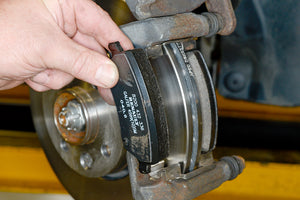What are brake pads?
Brake pads are pucks of high friction material glued or rivetted to a steel backing plate. They are installed in the brake callipers and squeezed against the brake discs by hydraulic pistons, which are moved by brake fluid that is forced against them by the master cylinder via your foot.
At one time, many years ago, brake pads were made out of mostly asbestos, but because of cancer concerns, they no longer are. However, you should never clean brake dust off with compressed air because the friston material is still not anything you want in your lungs. Even carbon ceramic and metalic brake pads leave dust that will irritate your lungs and could do worse.
 Rear disc brakes may require a special tool or procedure to retract the parking brake. Your Haynes manual has all the details.
Rear disc brakes may require a special tool or procedure to retract the parking brake. Your Haynes manual has all the details.When to change your brake pads
“Take a look at the edge of the pad inside the caliper for an indication of how worn they are”
It’s important that your rear brake pads are examined whenever the car is serviced and replaced when necessary, for safe operation. Your car may have an electronic sensor and warning light for when the pad has worn down, or a metal tab that squeals, but many don't. The best way to know for sure is to jack up the car, remove a rear wheel and examine the pads directly. Always check the rest of the brake system when replacing the pads - if the discs/rotors are worn thin, grooved, or warped have them machined smooth or consider replacing them.
All cars are slightly different, so if it is time to change your brake pads, use our before you begin checklist, and find your car for specific instructions.
Why brake pads need replacing
Brake pads are critical for the safe operation of your car, and should be maintained to avoid a potential disaster. If the pads wear down to the backing plate, stopping sistances will be a lot further and may cause an accident.
The friction material on the pads is slightly softer than the steel discs and with time, the pads wear down. Starting with more than 1/4 inch of material, a microscopic amount is rubbed off every time you stop. You'll need to replace them before the backing plate are rubbing the discs, or you will quickly need to replace the discs as well.
Some cars have brake pad wear indicators, which activate a light on the dashboard when the pads need replacing. A simpler wear indicator is a little metal tab which hits the disc and starts to squeal when they are 75% worn out. Another way of telling how worn the pads are is to examine the level of fluid in the brake fluid reservoir (which drops as the pad wears).
Haynes recommends inspecting the pads and measuring the wear whenever you have the wheels off to rotate the tires. This task requires some experience, but uses basic tools, and will take just a minute per wheel, if you already have the wheels off.
Before you begin
Tools you will need
Only basic tools are required for this job, except for a piston retraction tool needed on some cars. You will need to raise the car to remove the wheels.
- Floor jack and jack stands
- Lug wrench
- Ruler to measure pad thickness
- Wire brush
- Aerosol brake system cleaner
- Brake piston retraction tool
- Electronic scan tool (to retract piston on some cars)
- Ratchet and socket set
- Torque wrench
Parts you may need
- Brake pads
- Pad clips/springs
- High temperature grease
- Brake fluid
Every car is different, so before you view the full instructions, find yours…





















